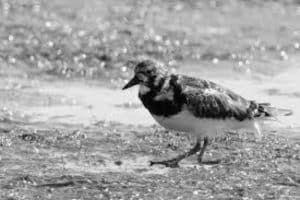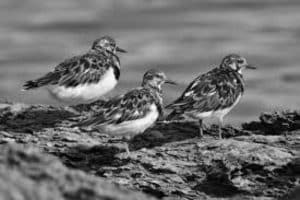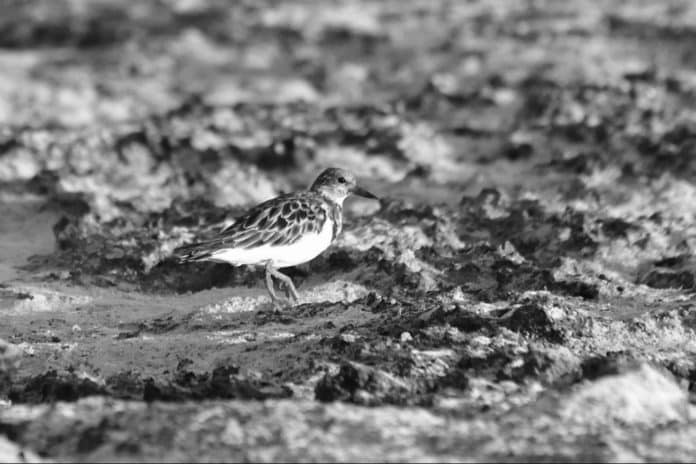Introduction to the Ruddy Turnstone bird
The Ruddy Turnstone is a fascinating bird species that can be found along the coastal regions of Tanzania. With its distinctive appearance and interesting behavior, it has become a popular subject for birdwatchers and nature enthusiasts. In this article, we will explore the habitat, physical characteristics, and behavior of the Ruddy Turnstone in Tanzania, as well as its migratory patterns, breeding habits, conservation status, and the best locations in Tanzania to spot this beautiful bird.
Habitat and distribution of the Ruddy Turnstone in Tanzania

The Ruddy Turnstone is mainly found in coastal areas, particularly along the shores of Tanzania. It prefers rocky shores, sandy beaches, and tidal flats, where it can feed on small invertebrates such as insects, crustaceans, and mollusks. This bird species is known for its ability to turn over stones and shells with its bill, hence its name “Turnstone.” The Ruddy Turnstone can also be found in estuaries, salt marshes, and mudflats, as these habitats provide ample food sources for its survival.
In Tanzania, the Ruddy Turnstone can be observed along the coastlines of the Indian Ocean, from Dar es Salaam in the east to the border with Mozambique in the south. It is a common sight on the islands of Zanzibar and Pemba, where it can be seen foraging on the sandy beaches and rocky shores. The Ruddy Turnstone is a migratory bird, and during the non-breeding season, it can be found in other parts of Africa, Asia, Europe, and North America.
Physical characteristics and behavior of the Ruddy Turnstone
The Ruddy Turnstone is a medium-sized bird, measuring around 9 to 10 inches in length and weighing approximately 3 to 5 ounces. It has a compact body with short legs and a medium-length bill. The plumage of the Ruddy Turnstone is quite striking, with a combination of ruddy brown, black, and white feathers. During the breeding season, the male Ruddy Turnstone displays more vibrant colors, with brighter ruddy tones on its back and chest.
One of the most interesting behaviors of the Ruddy Turnstone is its feeding technique. As mentioned earlier, it uses its bill to turn over stones and shells in search of food. It also uses its bill to probe into the sand and mud, extracting hidden prey. The Ruddy Turnstone is known for its agility and acrobatic movements, as it hops and jumps around rocks and other obstacles in its search for food. It has a distinctive call, which is a series of short, sharp notes.
Migratory patterns and breeding habits of the Ruddy Turnstone

The Ruddy Turnstone is a long-distance migratory bird, traveling thousands of miles each year. During the breeding season, which typically occurs from May to August, the Ruddy Turnstone migrates to the Arctic tundra in northern Canada and Alaska. Here, it forms breeding colonies and builds nests on the ground, using rocks, twigs, and vegetation. The female Ruddy Turnstone typically lays a clutch of four eggs, which both parents take turns incubating.
After the breeding season, the Ruddy Turnstone embarks on its epic journey southward. It follows a flyway that takes it through various countries, including the United States, Mexico, Central America, and the Caribbean. Along the way, it stops at key feeding grounds to replenish its energy reserves before continuing its migration. Tanzania serves as an important stopover site for the Ruddy Turnstone, providing essential food sources for the birds as they make their way to their wintering grounds.
Conservation status and threats to the Ruddy Turnstone population
The Ruddy Turnstone is currently listed as a species of least concern on the IUCN Red List. However, like many bird species, it faces various threats to its population. Habitat loss and degradation due to coastal development and pollution are major concerns for the Ruddy Turnstone. The destruction of important feeding and nesting sites can have a significant impact on the survival of this bird species.
Climate change is another threat that affects the Ruddy Turnstone. Rising sea levels and increased storm intensity can destroy nesting sites and disrupt the bird’s migratory patterns. Changes in temperature and weather patterns can also affect the availability of food sources for the Ruddy Turnstone. Conservation efforts are crucial to protect the habitats and ensure the survival of this beautiful coastal bird in Tanzania and other parts of the world.
Best locations in Tanzania to spot the Ruddy Turnstone
Tanzania offers several excellent locations for birdwatchers to spot the Ruddy Turnstone. One of the best places to observe this bird species is the Saadani National Park, located on the country’s coast. Here, visitors can witness the Ruddy Turnstone foraging on the sandy beaches and rocky shores, especially during low tide. Saadani National Park is also home to a diverse range of other bird species, making it a paradise for birdwatching enthusiasts.
Another top spot for spotting the Ruddy Turnstone is Zanzibar, an archipelago off the coast of Tanzania. The sandy beaches and tidal flats of Zanzibar provide the perfect feeding grounds for these birds. Visitors can take guided tours or explore the beaches independently, keeping an eye out for the distinctive plumage and feeding behavior of the Ruddy Turnstone. It is recommended to visit during the non-breeding season when the birds are more abundant.
Tips for birdwatching and photographing the Ruddy Turnstone in Tanzania

If you’re planning to go birdwatching and photographing the Ruddy Turnstone in Tanzania, here are some tips to enhance your experience:
- Bring binoculars and a telephoto lens: A good pair of binoculars will help you spot the Ruddy Turnstone from a distance, while a telephoto lens will allow you to capture detailed close-up shots.
- Be patient and observant: The Ruddy Turnstone can be quite active and may move quickly from one feeding spot to another. Take your time to observe their behavior and anticipate their movements.
- Respect their habitat: When observing the Ruddy Turnstone, make sure to minimize your impact on their environment. Avoid disturbing their nesting sites and do not approach too closely.
- Learn their calls and behavior: Familiarize yourself with the distinctive calls and behavior of the Ruddy Turnstone. This will help you locate them more easily and capture unique moments.
- Seek local guidance: Consider hiring a local birdwatching guide who is familiar with the best spots and timings for observing the Ruddy Turnstone. They can provide valuable insights and enhance your chances of a successful sighting.
Other coastal bird species to look out for in Tanzania
Tanzania is home to a rich diversity of bird species, especially along its coastal regions. In addition to the Ruddy Turnstone, birdwatchers can look out for other fascinating coastal birds such as:
- Crab Plover: This unique bird has a striking appearance, with its black and white plumage and long, red bill. It is commonly found along the sandy beaches of Tanzania, where it feeds on crabs and other small invertebrates.
- Sooty Gull: This large seabird can be spotted along the coastlines of Tanzania, particularly on rocky shores and islands. It has a dark plumage, a yellow bill, and a distinct call.
- Lesser Crested Tern: With its elegant flight and distinctive black crest, the Lesser Crested Tern is a beautiful bird species to watch. It can be seen hovering over the ocean and diving to catch fish.
- African Skimmer: Known for its unique feeding behavior, the African Skimmer glides just above the water’s surface, skimming it with its lower bill to catch small fish. It can be found in coastal areas and rivers in Tanzania.
Ecotourism opportunities and organizations supporting Ruddy Turnstone conservation in Tanzania
Tanzania offers several ecotourism opportunities for visitors who are interested in birdwatching and supporting conservation efforts. Many tour operators and organizations focus on promoting sustainable tourism practices and protecting the natural habitats of bird species like the Ruddy Turnstone. By participating in these eco-friendly tours, visitors can contribute to the conservation of the Ruddy Turnstone and other coastal birds in Tanzania.
One such organization is the Tanzania Bird Atlas Project, which aims to gather data on bird populations and distribution across the country. This information is vital for understanding the conservation needs of bird species like the Ruddy Turnstone and implementing effective conservation strategies. By supporting organizations like the Tanzania Bird Atlas Project, visitors can actively contribute to the preservation of Tanzania’s natural beauty and biodiversity.
Conclusion: Celebrating the natural beauty of Tanzania’s shores and the Ruddy Turnstone
Tanzania’s coastal regions are home to a diverse range of bird species, including the elegant Ruddy Turnstone. With its distinctive appearance and interesting behavior, the Ruddy Turnstone is a true marvel of nature. By exploring its habitat, understanding its migratory patterns, and appreciating its role in the coastal ecosystem, we can develop a deeper appreciation for this incredible bird species.
When visiting Tanzania’s shores, take the time to observe and admire the Ruddy Turnstone in its natural habitat. Remember to respect its environment and support conservation efforts that aim to protect this beautiful bird. By celebrating the natural beauty of Tanzania’s shores and the Ruddy Turnstone, we can ensure that future generations will also have the opportunity to experience the coastal elegance of this remarkable bird.


































